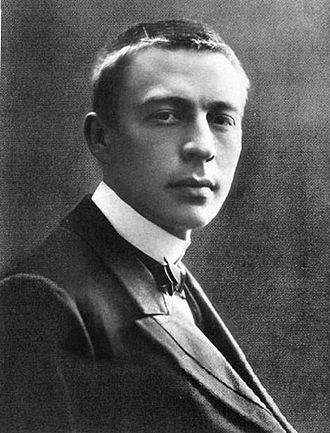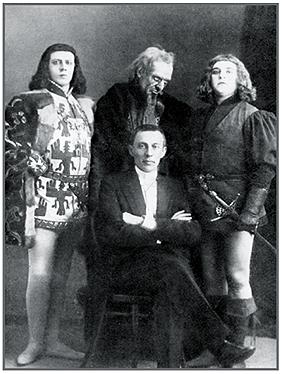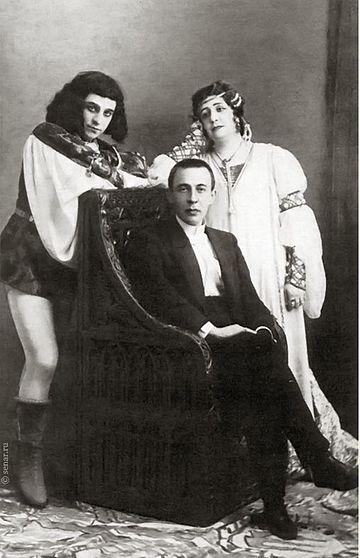Sergei Rachmaninoff, master pianist, composer and orchestrator, also tackled the genre of opera as early as his student days at the Moscow Conservatory, and made two other significant contributions in the early years of the 20th century. To commemorate Rachmaninoff's 150 birth anniversary this year, WETA VivaLaVoce, the all-vocal channel of WETAClassical, presents Rachmaninoff’s three completed operas on consecutive Tuesdays: April 11, 18 and 25, each at 8:00 p.m. (ET). All are recordings of the BBC Philharmonic, led by Gianandrea Noseda. Here are brief capsules about each.
Aleko: April 11
Aleko was Rachmaninoff’s first completed opera, composed for his graduation from Moscow Conservatory in 1892. This drama of betrayal and tragedy is based on the narrative verse, The Gypsies, by the great Russian poet, Alexander Pushkin.
With Aleko, Rachmaninoff made a significant step in the operatic genre -- it was praised by Conservatory judges and received its premiere with the Bolshoi Opera that same year with Rachmaninoff's role model, Tchaikovsky, in attendance. The work had successful runs in Kiev, St. Petersburg (where Rachmaninoff was to cement his relationship with the great operatic bass, Feodor Chaliapin), London and New York.
It is set in 13 short, separate segments. The story focuses on the character of Aleko, a Russian who has abandoned the city for a life in the country with a community of nomads referred to as gypsies. Aleko and a younger gypsy, Zemfira, become lovers. Zemfira defends free love and, weary of Aleko's possessiveness, takes a younger lover. An enraged Aleko murders the lovers and is ousted from the gypsy community. We may see reminiscences to Bizet's Carmen, another tragedy between city civilian and gypsy. Rachmaninoff’s musical language in Aleko teems with rich orchestral and choral textures, and senses of joy and brooding. We also hear echoes of liturgical chant that Rachmaninoff regularly experienced during his youth in the Russian Orthodox Church, musical devices that would figure in some of his future compositions.
The Miserly Knight: April 18
Twelve years separate Aleko from Rachmaninoff’s second opera, The Miserly Knight, composed in 1904. Rachmaninoff again turned to a narrative verse by Alexander Pushkin for the basis of this sad tale of the blinding effects of avarice. In fact, the libretto is set virtually word-to-word to Pushkin’s verse.
The opera bears the influence of Rimsky-Korsakov’s free-flowing narrative style and small, chamber-like quality that the elder composer employed in his opera, Mozart and Salieri. Rachmaninoff’s use of woodwinds, which often bolster the colorful scores of his orchestral music, is effectively used in The Miserly Knight to set a foreboding tone. Rachmaninoff was further influenced by his association with the esteemed Russian bass of his day, Feodor Chaliapin, for whom Rachmaninoff wrote the title role.
Rachmaninoff conducted the premiere of The Miserly Knight at Bolshoi Theater in Moscow in 1906, where he served as official conductor, in a double-bill that included his third opera, Francesca da Rimini.
The Miserly Knight is comprised of three scenes, solely for male singers. The story centers on a fractured relationship between a young knight, Albert, and his wealthy father, a baron, who gloats over his vast chests of gold. Albert’s lavish lifestyle places him deeply in debt, but his father refuses to loan money to Albert to pay off his debts, believing it would encourage his son’s freewheeling lifestyle. Desperate, Albert unsuccessfully seeks help from a money-lender, then asks a Duke to persuade the Baron to loan money to Albert. This results in a violent confrontation and duel between Albert and the Baron. The Duke denounces and banishes both. As the Baron collapses and dies from the stress of the incident, his last words are not for his son, but for the keys to his chests of gold.
Francesca da Rimini: April 25
Rachmaninoff’s third completed opera, Francesca da Rimini, dates from the same year as The Miserly Knight, although Francesca differs in its musical terms and source material. The libretto was provided by Modest Tchaikovsky and centers on the real-life 13th century Italian noblewoman, Francesca da Rimini, who was murdered by her husband, a military figure named Gianciotto Malatesta (referred to as Lanciotto in the opera), when he discovered her love affair with his brother, Paolo. Francesca figures prominently in the Second Circle of Inferno from Dante’s 14th century epic poem, Divine Comedy; in it, she relates the tragic series of events while Paulo looks on, silently weeping. As befitting the tragedy, the score is robust, with tones of turbulence, sorrow and tenderness, with choral sighs that represent condemned souls.
The work is set with an opening Prologue, two Tableaux, and an Epilogue. In the Prologue, the ancient poet, Virgil, and Dante visit the Second Circle of Inferno, where souls of sinners of lust are condemned and punished in an infernal whirlwind. They sing a sorrowful, wordless chorus. Then Francesca and Paulo tell their sad tale of their love and the adultery that led her husband to murder. In the following tableaux, Rachmaninoff reenacts Francesca and Lanciotto’s loveless marriage and the unfolding passion between Francesca and Paulo. In the Epilogue, Francesca and Paulo are enveloped into the whirlwind of Inferno’s Second Circle. Dante and Virgil reflect with horror and grief, concluding, “There is no greater sadness in the world than to remember a time of joy in a time of grief”.
We hope you'll tune in to these opera presentations on WETA VivaLaVoce and enjoy Rachmaninoff's arc as a composer of opera, from youth to maturity. Learn more about WETA VivaLaVoce’s presentation of these Rachmaninoff operas, and listen live, at https://weta.org/fm/vivalavoce.
PBS PASSPORT
Stream tens of thousands of hours of your PBS and local favorites with WETA+ and PBS Passport whenever and wherever you want. Catch up on a single episode or binge-watch full seasons before they air on TV.


